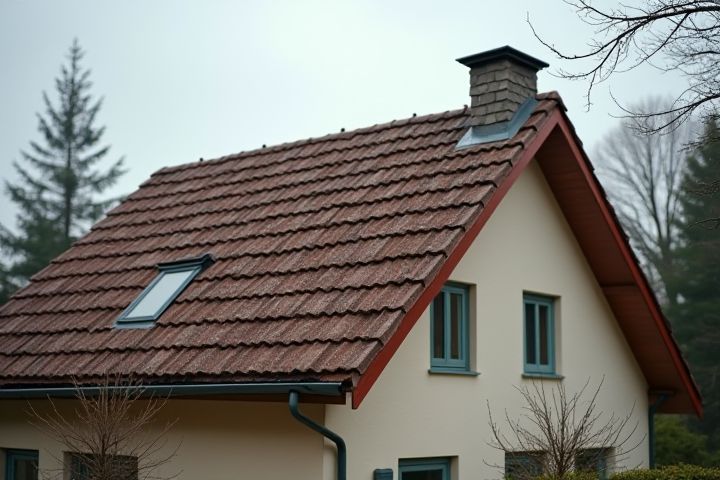
Slanted roofs, often referred to as pitched roofs, are designed primarily for effective water drainage and snow shedding. Their angular structure allows rainwater and melting snow to easily flow off, minimizing the risk of leaks and structural damage. This design also reduces the chance of ice dams forming, which can cause significant issues in colder climates. Moreover, slanted roofs can enhance attic ventilation, leading to improved air circulation and energy efficiency in your home. The aesthetic appeal of slanted roofs can also complement various architectural styles, providing both function and visual interest.
Why House Roofs Are Slanted
Water drainage efficiency
Slanted roofs are designed primarily for efficient water drainage, allowing rainwater and melting snow to flow off easily rather than accumulating on the surface. This design minimizes the risk of leaks and structural damage, as stagnant water can lead to wood rot and mold growth over time. The steepness of the slope often ranges from 4:12 to 12:12, significantly influencing the effectiveness of drainage and overall roof durability. By channeling water away quickly, slanted roofs enhance the longevity of roofing materials and maintain the integrity of the building beneath.
Prevents snow accumulation
Slanted roofs, or pitched roofs, play a crucial role in preventing snow accumulation, effectively managing weight and facilitating drainage. A steep angle allows snow to slide off easily, reducing the risk of structural damage that can occur if heavy snow accumulates. In regions that experience significant snowfall, a slope of at least 30 degrees is often recommended to minimize the potential for collapses. By ensuring that snow does not linger on the surface, slanted roofs help maintain your home's longevity and structural integrity.
Reduces wind resistance
Slanted roofs, commonly known as pitched roofs, effectively reduce wind resistance due to their aerodynamic shape. By directing wind over the sloped surfaces, these roofs minimize the pressure and uplift forces that can lead to structural damage. This design not only enhances durability but also promotes effective water drainage, preventing leaks and moisture buildup. For homeowners, slanted roofs provide an ideal balance of aesthetics and functionality while contributing to overall energy efficiency.
Enhances structural stability
Slanted roofs, or pitched roofs, enhance structural stability by effectively directing rainwater and snow away from the building, minimizing water accumulation that could lead to leaks or structural damage. This design helps reduce the weight of snow and ice buildup, preventing stress on the underlying framework, which can be critical in areas susceptible to harsh weather conditions. A slope of 4:12 or steeper is often recommended to ensure proper drainage and avoid common problems associated with flat roofs. By choosing a slanted roofing system, you invest in a more resilient and longer-lasting structure that withstands the elements efficiently.
Increases attic space
A slanted roof design significantly enhances attic space, allowing for better storage solutions or potential living areas. This architectural style increases vertical height in the attic, making it easier to utilize the area effectively. With an average increase of 30% in usable space compared to flat roofs, homeowners can capitalize on this extra room for a variety of purposes, such as home offices, playrooms, or additional bedroom space. Maximizing attic space ultimately adds to your property value and overall functionality of the house.
Improves thermal insulation
Slanted roofs enhance thermal insulation by facilitating better airflow and reducing heat retention in warmer climates. The tilt allows rain and snow to slide off easily, preventing moisture accumulation that can lead to mold and reduced insulation efficiency. This design can also create an attic space, which acts as a buffer zone, helping to regulate indoor temperatures by keeping the living areas cooler in summer and warmer in winter. By choosing a slanted roof, you can significantly improve your home's energy efficiency and comfort year-round.
Adds architectural aesthetic
Slanted roofs, or pitched roofs, enhance architectural aesthetics by creating a visually appealing silhouette that contributes to a building's character. This design allows for the incorporation of intricate rooflines, which can elevate the overall architectural style, from traditional to contemporary. Beyond aesthetics, slanted roofs facilitate efficient water drainage, preventing pooling and water damage, thereby prolonging the lifespan of roofing materials. You can also enjoy increased attic space, which may serve as functional areas, further enhancing the home's design and usability.
Minimizes debris build-up
Slanted roofs effectively minimize debris build-up, as their angled surfaces allow rain, snow, and leaves to easily slide off. This design reduces the risk of water pooling, which can lead to leaks and structural damage over time. In areas with heavy snowfall, slanted roofs prevent excessive weight accumulation that could compromise the integrity of the roof. You can enhance your home's longevity by choosing this roofing style, ensuring efficient drainage and less maintenance.
Facilitates solar panel installation
Slanted roofs facilitate solar panel installation by providing an optimal angle for sunlight exposure, enhancing energy absorption. The incline minimizes shading from nearby structures and trees, ensuring maximum efficiency of solar energy capture. Typically, a pitch of 30 to 45 degrees is ideal for photovoltaic panels, allowing gravity to assist in rainwater drainage, which keeps the panels clean and increases their longevity. This design not only improves the performance of your solar system but also contributes to the overall aesthetic appeal of the home.
Supports rainwater collection systems
Slanted roofs, often engineered with specific angles, facilitate efficient rainwater drainage, preventing water accumulation that can lead to structural damage. This design not only enhances the lifespan of roofing materials but also supports the integration of rainwater collection systems, which can capture significant amounts of precipitation--potentially thousands of gallons annually in some regions. By directing runoff towards gutters and downspouts, slanted roofs optimize the harvesting of rainwater for irrigation or household use. Thus, these roofs ensure effective management of rainfall while promoting sustainability through efficient water resource utilization.
